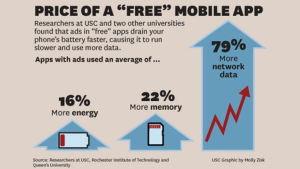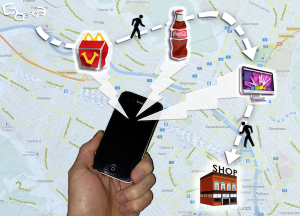Whether you bank, tweet, or steam music on your smartphone, chances are you’ve downloaded at least one of these apps for free. Thirty million mobile apps are downloaded each day, and more than 90 percent of them are advertised at no cost. If these apps are truly free, then why is it that the mobile app market hits over $50 billion in annual revenue and mobile app designers bring home $90k per year on average (Laird, 2012)? Here are the reasons why free apps end up costing you more than you think:
 Loss of Privacy
Loss of Privacy
When was the last time you read through the terms and conditions before downloading a free app? Chances are, not for a while. Although the app is downloaded for free, the fine lines in its terms and conditions state that your personal information will be used and sold to advertisers and third party companies. Free apps are 401 percent more likely to collect your personal information than paid ads (Tynman, 2012). Some of the most common information collected from your smartphone includes your location, unique serial-number-like identifiers for the phone, and personal details such as age, sex, etc. Some free apps even take it a step further and are allowed access to your address books, photos, and social media accounts (Whitman, 2012).
 Data Spikes and Battery Drains
Data Spikes and Battery Drains
Free apps cost you big on data and battery without you even realizing it. Researchers at USC and two other universities found that compared to apps without ads, apps with ads are a big drain on your battery, take up more processing time, and also increase data usage by 79 percent on average (Pinola, 2015). Apps even use data in the background when its not being used so that it can continuously track and record your personal information such as your GPS location (Dachis, 2012).
Your Purchasing Decisions Are Influenced
 Free apps significantly rely on advertising revenue in comparison to paid apps. According to a survey of more than 1,400 mobile users, about 2 in 3 people would be likely to add a product to their shopping list if were to see it on a mobile advertisement (Pew Research, 2015). In addition, respondents also indicated that the following types of advertisements on their smartphone would most likely influence their purchasing decisions: a coupon for a product in-store (28%); sale item notification (20%); and seeing an ad for a product (15%) (MarketingCharts.com, 2013). In addition, many companies today use a feature called “geo-targeting” to track their target audiences. For example, if I was a company that wanted to sell a product to 18-24 year olds, I could use geo-targeted marketing to find out where the audience frequents and push ads to them when they enter or exit that specific location. The location of these audiences are tracked and sold by free apps that are downloaded on their smartphones (Murphy, 2011).
Free apps significantly rely on advertising revenue in comparison to paid apps. According to a survey of more than 1,400 mobile users, about 2 in 3 people would be likely to add a product to their shopping list if were to see it on a mobile advertisement (Pew Research, 2015). In addition, respondents also indicated that the following types of advertisements on their smartphone would most likely influence their purchasing decisions: a coupon for a product in-store (28%); sale item notification (20%); and seeing an ad for a product (15%) (MarketingCharts.com, 2013). In addition, many companies today use a feature called “geo-targeting” to track their target audiences. For example, if I was a company that wanted to sell a product to 18-24 year olds, I could use geo-targeted marketing to find out where the audience frequents and push ads to them when they enter or exit that specific location. The location of these audiences are tracked and sold by free apps that are downloaded on their smartphones (Murphy, 2011).
References
Dachis, A. (2012). How to Stop Your Smartphone from Secretly Wasting Data in the Background. Retrieved from http://lifehacker.com/5957947/how-to-figure-out-which-apps-are-using-your-smartphones-cellular-data-without-your-knowledge
Laird, S. (2012). So You Want to Be an App Developer? Here’s How . Retrieved from http://mashable.com/2012/08/27/app-developer-infographic/
MarketingCharts.com. (2013). Mobile Ads Seen Impacting CPG Purchase Decisions. Retrieved from http://www.marketingcharts.com/online/mobile-ads-seen-impacting-cpg-purchase-decisions-38286/
Murphy, D. (2011). The Geo-Targeting Revolution. Retrieved from http://mobilemarketingmagazine.com/geo-targeting-revolution/
Pew Research. (2015). U.S. Smartphone Use in 2015. Retrieved from http://www.pewinternet.org/2015/04/01/us-smartphone-use-in-2015/
Pinola, M. (2015). The Real Cost Of Free Mobile Apps: 79% More Data Use, 16% Battery Hit. Retrieved from http://www.lifehacker.com.au/2015/04/the-real-cost-of-free-mobile-apps-79-more-data-use-16-battery-hit/
Tynman, D. (2012). Those free apps can cost you big. Retrieved from http://www.itworld.com/article/2717594/it-management/those-free-apps-can-cost-you-big.html
Whitman, R. (2012). The horror: Android allows apps access to your pictures. Retrieved from http://www.extremetech.com/computing/120969-the-horror-android-allows-apps-access-to-your-pictures

7 Responses to 3 Reasons Why Free Mobile Apps End up Costing You